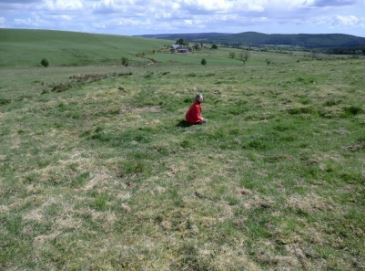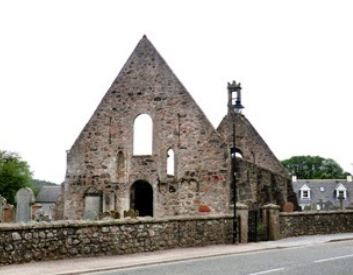Article 2 - St Erchard
Article 2 - St Erchard
Date of death – Not Known
Feast day – 24th August
Birthplace – Tolmauds, Grid Ref NJ 597072
Well – Grid Ref NO 594998
Church – Grid Ref NO 592997
If folklore is accurate, St Erchard is our only locally born Saint. All accounts link him to St Ternan of Banchory, but as in the case of St Ternan, accounts vary as to his dates being between the 5th and the 7th Centuries. If I am going to run with the story of St Erchard being a pupil of St Ternan I am going to have to date him in the 7th century.
All accounts have the young Erchard being born at Tolmauds. The name survives in that of a farm called Wester Tolmauds four miles north of Kincardine o’Neil . About 400 m west of the farm steadings lie two hut circles of about 12 to 15 m radius, clearly visible on the ground and marked on the OS Map, which may have been part of a larger settlement. These hut circles are of standard shape and size with the many other hut circles all over the North East of Scotland but as far as I know these are the only ones where a historical figure known to us is said to have been born. Hut circles are notoriously difficult to photograph and my photograph bears this out. They are much more visible on the ground.

The Aberdeen Breviary will be referred to during the course of these articles. It is important to describe what this is. A Breviary contains the set of prayers that every priest is obliged to say at various times of day throughout the year. What makes the Aberdeen Breviary different is that it includes text to celebrate Scottish Saints who would not be included in Breviaries printed elsewhere. It was compiled by Bishop Elphinstone of Aberdeen, and became the first major book to be printed in Scotland in 1509. The information on the Saints was compiled by a team of clerics who toured Scotland visiting each parish and recording what evidence was available about the local Saint or Saints. This team is thought to have included Alexander Galloway sometime Parson of Kinkell near Inverurie and latterly a Canon of St Machars Cathedral and one of the foremost scholars of his day. Nevertheless, however good the scholarship and intentions, the team could do no more than collect the information supplied to them by the parishes however accurate or inaccurate that may be. But it is a starting point from which other research has evolved.
Let us therefore start by seeing what The Breviary says about Erchard. In the first place it calls him M’erchard which is a term of affection meaning Mo or My Erchard. He is described as a native of Kincardine o’Neil who became a zealous Christian in his early youth and was ordained a priest by Ternan. While working with Ternan, he visited Glenmoriston. Later he went to Rome and was consecrated bishop by Pope Gregory. On his return journey he visited the Picts of Pictavia, now Poitou in France, and brought back to the truth such as had lapsed to paganism. Falling sick, he prayed to God that he might not see death till he arrived in his own country, and hastened northward through France and England. He reached Kincardine o’Neil to be honourably received by his people, and then died. According to his own instructions, his body was placed on a cart drawn by two horses, which were allowed to go forth where they listed. He was buried where they first stopped, and a church was built over his grave. That place was the site of the now ruined medieval church in Kincardine o’Neil.
There are certain problems with this account. Gregory lived from 540 to 604 and was Pope from 590. If I am right in dating Ternan and Erchard into the 7th century, then it is not possible for Erchard to have lived to what appears to be a good age before Gregory’s death in 604. Here we are again up against Douglas Simpson’s “stormy waters of controversy”. It is a dispute between the adherents of the old Celtic church who claim that it was independent of Rome, and the Roman Church itself, who they claim invented visits by our Saints to Rome to demonstrate that the Celtic Church was really a loyal adherent of the Pope. No one can prove whether Erchard went to Rome or not so I will steer round that whirlpool of controversy.
What I can say with some certainty however is that Kincardine o’Neil has been an important settlement since the earliest times. The Cairn o’Mount crossing of the Mounth has been used since Neolithic times, and Kincardine o’Neil has always been one of the crossing points of the Dee used to reach it. This is acknowledged by Aberdeenshire Council who expose signs on the road informing us that it is “The oldest village on Deeside”. The Breviary’s story of Erchard’s return to Kincardine o’Neil from Rome and his apparently immediate death gives no detail of his life there, except to say that he was honourably received on his return. Much of his life before the visit to Rome was spent in Western Scotland, from where we learn in the traditions of Glenmoriston about his bell. Erchard observed that a cow which had not eaten all day went home at night apparently well fed, and to investigate he dug up the spot where the cow had been standing and found three hand bells new and burnished as if fresh from the makers hands. Giving a bell to his two companions they all resolved to build a church at the spot where the bell rang by itself for the third time. In Erchard’s case the bell rang for the third time at the spot by the side of the river Moriston which is now the old burial ground of Glenmoriston, and there he built his church Clachan Mhercheird. Like Ternan’s bell, this one was preserved until after the Reformation, but then went missing.
I can however bring you a photo of St Erchard’s Well in Kincardine o’Neil. Indeed there are two wells that claim that honour. Next to the Hotel, and nearly opposite the medieval Church is a Victorian structure which bears the inscription “St Erchard”, but has no water



Lastly we have the church. The present ruin is of interest because Edward I of England is said to have worshiped there when he camped at Kincardine o’Neil in 1303 on his way south from Elgin, and also because to its immediate east can be seen the foundation of the wall of the Spital which once abutted it. But that was long after St Erchard’s day. If the story of the site of the church being chosen by the random stoppage of the two horses drawing the saint’s dead body is true that would fit with the site of the original settlement being somewhere near the original well. No trace remains of the original church, but the size and ornate features of the medieval church confirm the importance of the site of the village which lasted from prehistoric times even before St Erchard until the 19th century when the railway builders decided to take the line through Torphins and Lumphanan and not through Kincardine o’Neil.
Another well can be seen by proceeding towards Aberdeen and turning left at the second road up Neil Burn Drive and following that road round to the right when you will come to a structure by the roadside bearing the inscription “Eternity Wisdom”, which gushes water abundantly. The original St Erchard’s Well is said to have been in the field opposite, but to enable the field to be ploughed, the water was piped to this point. Both wells in their day have probably taken water from the same source which would have dictated the site of the original settlement which is now Kincardine o’Neil.
© Hugh Cochran 2012
Discover more…
